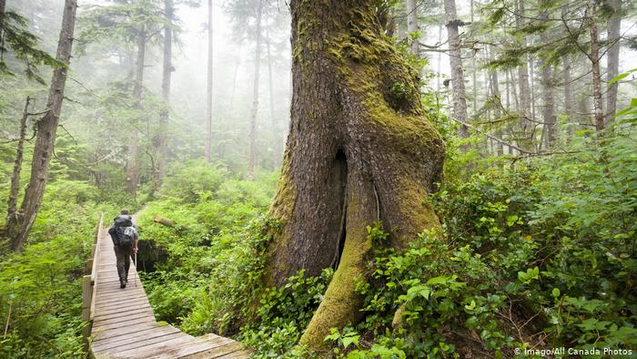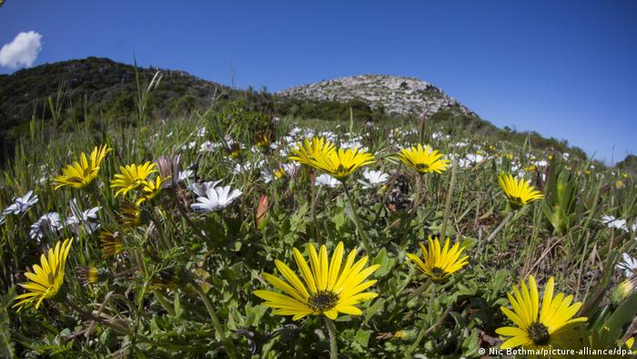A new UN blueprint offers an integrated 'peace plan' to tackle three interlinked environmental emergencies — the climate crisis, biodiversity loss and pollution — that cannot be solved in isolation.

|
|
Humans are not separate from nature - but a part of
it.
|
As climate change-inducing emissions continue to rise, biodiversity loss accelerates and new pandemics emerge, solutions have proved inadequate in isolation. In response, the Making Peace with Nature report is a "blueprint to urgently solve planetary emergencies" via a synthesis of diverse global environmental assessments.
These include reports by the Intergovernmental Panel on Climate Change (IPCC), the Intergovernmental Science-Policy Platform for Biodiversity and Ecosystem Services, the UNEP's Global Environment Outlook report and research on zoonotic diseases such as COVID-19.
Antonio Guterres: humanity is waging war on nature
Failure to tackle interwoven crises
The UNEP's cross-disciplinary approach aims to tackle interlinked environmental crises within the framework of the UN's 2030 Sustainable Development Goals, and to lay the groundwork for achieving carbon neutrality by 2050.
"The report makes the strongest scientific case yet for why and how that collective determination must be urgently applied to protecting and restoring our planet," wrote Inger Andersen, Executive Director of UNEP, in a forward to Making Peace with Nature.
The often piecemeal response to the climate crisis, biodiversity loss and pollution is "not going to get us to where we want," Andersen told DW.
Such an uncoordinated response has contributed to the fact that the world is on track to warm at least 3 degrees Celcius above pre-industrial levels by 2100 — despite a temporary decline in emissions due to the pandemic. That is double the 1.5 warming mandated in the Paris targets, which would require a 45% global emission reduction by 2030.
Meanwhile, over 1 million of an estimated 8 million plant and animal species are at risk of extinction, and pollution-related diseases kill some 9 million people annually, according to an analysis published in The Lancet in 2018.

|
'Natural capital' as a core economic measure
As part of the Making Peace with Nature report's holistic approach to tackling widespread environmental decline, the authors especially target the massive economic costs of failure to take rapid action in the next decade.
The report details our reliance on what it calls "natural capital" for livelihoods, prosperity, health and well-being, and outlines how that value is unevenly distributed. Moreover, while humanity depends on the Earth and its ecosystems and draws benefit from nature, this dependence is not accounted for in current economic and financial systems.
"By transforming how we view nature, we can recognize its true value," said António Guterres. "By reflecting this value in policies, plans and economic systems, we can channel investments into activities that restore nature and are rewarded for it."
Natural capital is calculated by assessing, among other factors, the costs and benefits of land degradation, climate change mitigation and adaption, biodiversity loss and air and water pollution.
Extreme poverty and hunger demand growth, explained Inger Andersen, adding that our "produced capital" has doubled since 1990.
"But our natural capital, these blocks of life, our geology, our air and water, the soil and so on, that capital has lost 40% of value," she told DW.
Look forward to the launch today of new @UNEP report Making #PeaceWithNature. This powerful synthesis of science reminds us that is indeed possible to overcome the #ClimateCrisis, #nature loss & #pollution.The UNEP calculates that natural capital constitutes around 20% of so-called planetary wealth (in addition to human capital, manufactured capital and so on). However, the standard economic measure, gross domestic product (GDP), both excludes the value of ecosystems that regulate the environment, and fails to measure the loss of natural capital associated with environmental depletion and destruction.
Grateful for support of @EU_Commission & Norwegian Environment Agency. pic.twitter.com/ZHjkfPrdEq
— Inger Andersen (@andersen_inger) February 18, 2021
While GDP measures current income, it fails to acknowledge how much of that value is sustainable. "Supporting current income through depletion of natural capital is not sustainable," the report states.
"You can fish the proverbial waters empty and then have a great quarterly return, and then what?" said Inger Andersen.
A better measure of sustainable economic growth known as "inclusive wealth" needs to be adopted in lieu of GDP because it accounts for declines in natural capital and acknowledges the adoption of a circular and sustainable economic system.

|
|
Environmental degradation needs to be priced into calculations of
economic growth, says the UNEP
|

|
|
Protecting biodiversity will be incorporated into climate
measures as part of the UNEP 'peace plan'
|
Mechanisms to limit climate-inducing emissions such as a carbon price and the phase-out of fossil fuel subsidies must be implemented globally, says the report.
The more than US$5 trillion (€4.2 trillion) in annual subsidies to fossil fuels, non-sustainable agriculture and fishing, non-renewable energy, mining, and transportation must be rechanneled to support low-carbon, sustainable technologies.
Shifting taxation from production and labor to resource use and waste is another way to promote a circular, low-impact economy. Low-interest green financing in developing countries will also encourage a shift away from carbon-intensive and environmentally degrading industries.
Tackling planetary threats as one
But how will such transformative change be implemented globally in the next decade?
As part of what Guterres calls a "peace plan" and a "post-war rebuilding program," the report says that households and civil society groups can initiate and lead transformations in addition to the private sector, labor organizations, educational bodies and media. Governments will need to guide these efforts via international cooperation and legislation.
2021 will be a defining year for such synergistic cooperation during global climate and biodiversity conferences including the November COP 26 in Glasgow and the COP 15 UN Biodiversity Convention, due to be hosted by China in May.
"We've put this together precisely so civil society groups, NGOs, academia, educational groups and activists around the world can access it," said Inger Andersen of disseminating the key messages in Making Peace with Nature.
Shareholders and pension funds who want to make more sustainable investments have also been targeted. "This needs to be an all-of-society effort," she told DW.
What’s in the air we breathe?
Links
- UN Report: Making Peace With Nature
- A new UN report urges a radical shift in the way we think about nature
- Making Peace With Nature: Where Actions Equal Science
- UN: Huge Changes in Society Needed to Make Peace with Nature
- Human Destruction of Nature Is “Senseless and Suicidal”
- UNDP's Achim Steiner: 'If we cannot decouple economic growth from emissions, we are doomed'
- Climate policy in 2021 'key' to hitting net-zero pledges
- UN report: 'Woefully inadequate' climate pledges spell 3.2C temperature rise

No comments :
Post a Comment